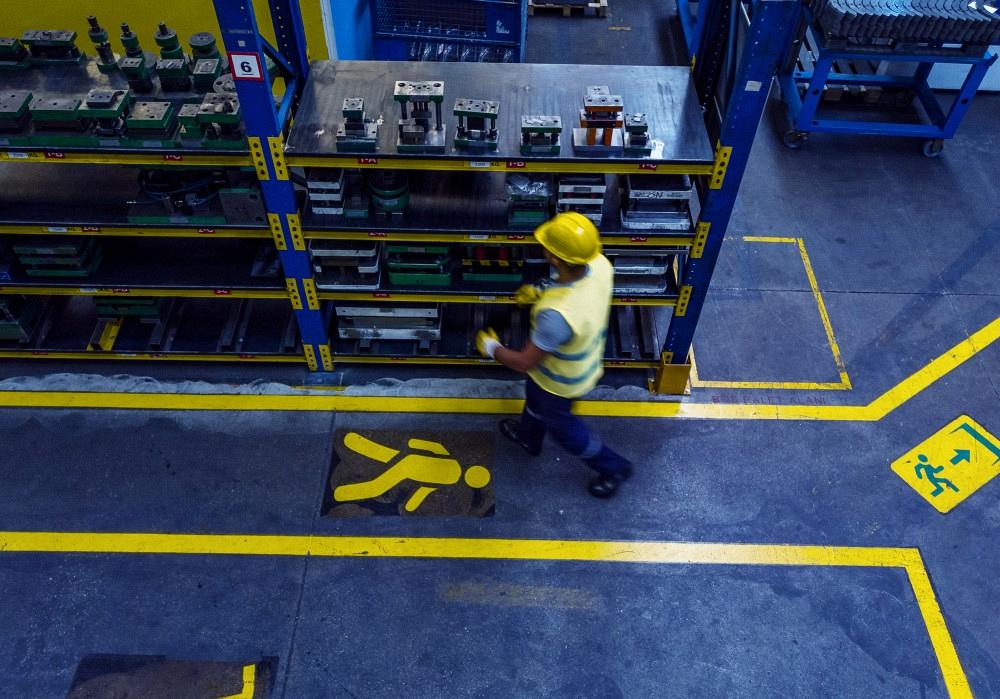- FMA
- The Fabricator
- FABTECH
- Canadian Metalworking
Categories
- Additive Manufacturing
- Aluminum Welding
- Arc Welding
- Assembly and Joining
- Automation and Robotics
- Bending and Forming
- Consumables
- Cutting and Weld Prep
- Electric Vehicles
- En Español
- Finishing
- Hydroforming
- Laser Cutting
- Laser Welding
- Machining
- Manufacturing Software
- Materials Handling
- Metals/Materials
- Oxyfuel Cutting
- Plasma Cutting
- Power Tools
- Punching and Other Holemaking
- Roll Forming
- Safety
- Sawing
- Shearing
- Shop Management
- Testing and Measuring
- Tube and Pipe Fabrication
- Tube and Pipe Production
- Waterjet Cutting
Industry Directory
Webcasts
Podcasts
FAB 40
Advertise
Subscribe
Account Login
Search
Ask the Stamping Expert: How do shops achieve consistent best-in-class quality?
The goal for any stamping manufacturer is to make every part the same
- By Thomas Vacca
- July 8, 2021
- Article
- Bending and Forming

The focus of a metal stamping team should be to minimize process variation and, as a result, non-value-added tasks. Getty Images
Q: How do we achieve consistent best-in-class quality?
A: Quality used to be defined by whether your part met the print. Not anymore. Today quality depends on process consistency. Before you can control the quality of your output, you have to control the consistency of your processes.
Unfortunately, part inspection is a non-value-added task. Just imagine if you knew every part you produced was perfect. Think of the time and money you would save not having to do first-off part inspections, in-process inspections, gauging, and fixturing for inspection, plus all the saved costs of returns, rework, and scrap related to poor quality. And we haven’t even mentioned the floor space in your facility that would be freed up with no need for all that equipment.
Tooling Law No. 2 from my 10 Tooling Laws defines quality as consistency. Many of you might say that quality is defined as a part to print, but I say no. I do not care about the part dimensions. I only care that every part is exactly the same. Once you can achieve that, it’s easy to change the actual dimensions by making tool changes. But if every part is different—even if they all meet print—then there is no quality.
The goal, plain and simple, is to make every part the same every time. That’s what statistical process control is all about: process capability. It’s a measure of process variation. That’s why the CP index—a measure of process stability—is more important than the CPK index—a measure of the process variation relative to the actual part specification. Your process could have an awesome CP (virtually no variation), but still be out of spec with an unacceptable CPK. This is a great place to be! You can then adjust the tooling to get any dimension you want.
Tooling Design
Years ago the goal in stamping was to design a die that could produce millions of parts and meet cost margins. Today tolerances are being squeezed so tightly that you also must focus your design on reducing variation in the tooling. I understand the frustration in trying to maintain cost control with overseas competition, but in the long run, it is better to pay 20% to 30% more in upfront tooling costs and deliver a tool that produces a consistent product. Over the years of a program, a poorly built tool can cost tens to hundreds of thousands of dollars in re-engineering costs, the costs of poor quality relative to rejects and rework, and poor customer satisfaction. Basically, pay now or pay later!
The most important goal is to design a tool with maximum stability that will yield consistent parts with as little variation as possible. The most common problem I have encountered in the design phase is lack of thorough analysis of each progression in the tool relative to causes of variation. When was the last time, during strip layout review, that you brainstormed how the part dimensions might vary based on the work being done in that station of the tool?
Here are the most common tooling issues that result in part variation:
- Stock lace-up point. The stock lace-up point should be designed so you can lace up without creating half-slugs that can get stuck in the die and cause breakage.
- Press stroke. Have you minimized press stroke? Running 200 strokes per minute with a 2-in. stroke is essentially the same as running 400 SPM with a 1-in. stroke.
- Slug controls. Be sure to put appropriate slug controls—such as slug notches in the die sections, vacuums, punch rooftops, and slug darts—into the design.
- Die features. Don’t try to skimp on die features, even if they increase cost. Sometimes beefing up the die shoe to prevent flexing, using larger-diameter guide pins, or adding some extra stations in the tool where you see significant risk is a wise decision. It’s much better than trying to address robustness by adding a restrike station after the tool is built. If you can move the press ram up or down to affect the part, your die construction is not robust enough to eliminate the variation caused by the actual stamping process. If you calculate that you need a 3-in.-thick shoe, try using 4 in. A 3-ft.-long die needs one guide pin per foot—three in front and three in back—with 1.25- to 1.5-in.-dia. minimum.
- Tool support. Review the press the tool will go into and make sure the press bolster opening will support the tool where work is being done. If the press bolster plate has a large cutout in the middle to accommodate scrap, then the bottom of the die shoe is not supported sufficiently to prevent the shoe from flexing. A tool flex of even a few thousandths of an inch is a common problem that leads to part variation. You might need a custom support plate under your die shoe.
- Die springs. Calculate the spring pressure required in your tooling using the 3-1 rule: Design in springs that are three times stronger than required. Use standard nitrogen die springs and avoid round wire coil springs cut to length when possible. Dimensional problems very often are caused by substandard stripper springs that allow the strip to move while being worked, as well as spring-loaded forming stations that are not preloaded enough to do the work on contact without allowing the part to flex.
- Sensors and stock support liners. These must be engineered in. Die designers often leave out feed-to-die support liners and buckle sensors and expect the pressroom to put something together. That’s a mistake. At minimum, include a micron sensor to detect slug pulls, a misfeed sensor for stock feeding issues, a buckle sensor for stock infeed issues, and a loop sensor between the coil stock and press feed. If you can, build in part-out sensors as well.
- Check list. Probably one of the most important keys to success is a progressive die design check list. This check list is a living document that will change with every die build so you can use it to make subsequent die builds more effective. After every build, sit with the team and discuss each problem that was addressed in development. What could you do differently in the design phase to eliminate the problem before it requires development time? Add these items to your check list!
Raw Material
Stampers often encounter coil-to-coil irregularities in their materials from the mill, and that causes part variation. You have the right to request that your mill hold size and mechanical property tolerances tighter than industry standards.
For example, the yield strength between 1/4 and 1/2 hard stainless steel can come very close to overlapping, and that will definitely cause variation in forming. In addition, for thin-gauge materials (0.015 in. and thinner), it’s wise to specify tension leveling. For consistent material feeding, you really need to minimize raw material waviness and camber.
Reducing Variation Is Key
Over the years customers have moved from requesting that production “meet print” to demanding that it meet statistical requirements. Six Sigma statistical philosophies are all about one thing: reducing variation. Even if your part measures to print, if mating components’ dimensions vary from one extreme to another, failure will result because stackups of mating components may affect the functionality of the assembly.
Manufacturers often get caught up in “my part meets print mode,” but the customer just wants an assembly that works the same every time. When the customer has functionality issues, it affects sales, profits, and customer satisfaction. At that point it doesn’t matter if the component meets print, because everyone comes out a loser.
Once you have reduced the variation in your tooling, material, press, personnel, and process, quality will follow naturally as a result. The focus of the manufacturing team should be to minimize process variation. The result will be many happy customers and improved profits through the minimization of non-value-added tasks.
About the Author

Thomas Vacca
Micro Co.
Has a shop floor stamping or tool and die question stumped you? If so, send your questions to kateb@thefabricator.com to be answered by Thomas Vacca, director of engineering at Micro Co.
subscribe now

The Fabricator is North America's leading magazine for the metal forming and fabricating industry. The magazine delivers the news, technical articles, and case histories that enable fabricators to do their jobs more efficiently. The Fabricator has served the industry since 1970.
start your free subscription- Stay connected from anywhere

Easily access valuable industry resources now with full access to the digital edition of The Fabricator.

Easily access valuable industry resources now with full access to the digital edition of The Welder.

Easily access valuable industry resources now with full access to the digital edition of The Tube and Pipe Journal.
- Podcasting
- Podcast:
- The Fabricator Podcast
- Published:
- 04/30/2024
- Running Time:
- 53:00
Seth Feldman of Iowa-based Wertzbaugher Services joins The Fabricator Podcast to offer his take as a Gen Zer...
- Industry Events
Pipe and Tube Conference
- May 21 - 22, 2024
- Omaha, NE
World-Class Roll Forming Workshop
- June 5 - 6, 2024
- Louisville, KY
Advanced Laser Application Workshop
- June 25 - 27, 2024
- Novi, MI
Precision Press Brake Certificate Course
- July 31 - August 1, 2024
- Elgin,
































